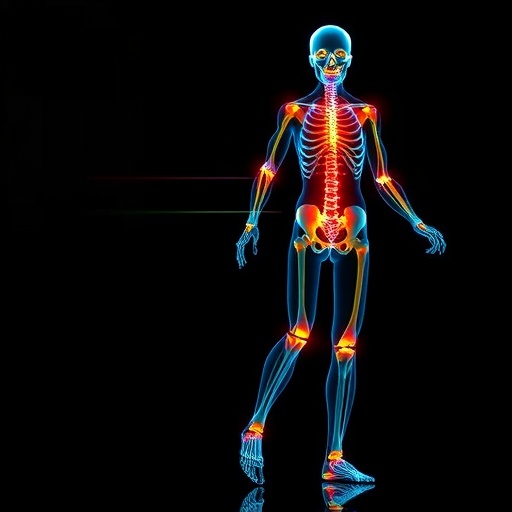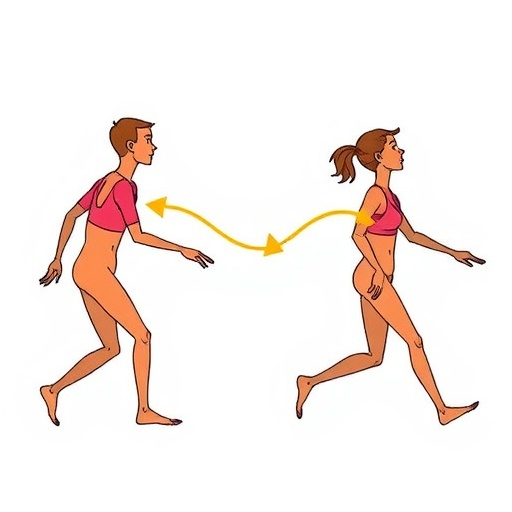In recent years, the integration of artificial intelligence and biomechanics has opened transformative pathways in healthcare, particularly in musculoskeletal research and rehabilitation medicine. A groundbreaking study published in Nature Communications in 2025—titled Utility of synthetic musculoskeletal gaits for generalizable healthcare applications—heralds a new era where synthetic gait data can revolutionize how clinicians and researchers approach musculoskeletal health across diverse populations. This research not only introduces innovative computational models that simulate human gait but also demonstrates wide-ranging applications that promise to enhance diagnostic precision, therapeutic customization, and predictive healthcare analytics.
Human gait, the manner or pattern of walking, is a complex biomechanical process emerging from the synchronized activity of muscles, bones, joints, and neural control systems. Traditionally, analyzing gait involved capturing motion data from human subjects using sophisticated motion-capture laboratories, wearable sensors, or video analysis. This approach, while effective, is inherently limited by factors such as inter-individual variability, experimental costs, and ethical concerns surrounding data collection from vulnerable populations. The novel research by Yamada, Kobayashi, Shinkawa, and colleagues directly addresses these challenges by developing high-fidelity synthetic musculoskeletal gait data, offering a scalable and ethically unobtrusive alternative to real-world gait data acquisition.
At the core of this study lies an advanced musculoskeletal modeling framework that employs state-of-the-art machine learning techniques combined with biomechanical simulations. The team crafted a generative model capable of producing synthetic gait trajectories that retain physiological plausibility and biomechanical realism. Unlike previous synthetic datasets, which often lacked complexity or failed to generalize across different physical conditions, this model incorporated detailed musculoskeletal constraints, including muscle-tendon dynamics, joint torque limits, and adaptive neural control patterns. Such integration ensured that the synthetic gaits maintained biomechanical validity across a range of simulated human phenotypes and clinical conditions.
.adsslot_fcZJxbzKri{ width:728px !important; height:90px !important; }
@media (max-width:1199px) { .adsslot_fcZJxbzKri{ width:468px !important; height:60px !important; } }
@media (max-width:767px) { .adsslot_fcZJxbzKri{ width:320px !important; height:50px !important; } }
ADVERTISEMENT
One of the most compelling aspects of this research is the validation strategy. The researchers compared synthetic gaits with empirical gait datasets collected from diverse populations, including healthy individuals and patients with musculoskeletal impairments such as osteoarthritis, cerebral palsy, and post-stroke hemiparesis. Quantitative analyses demonstrated striking concordance between real and synthetic gait parameters, such as joint angles, ground reaction forces, and muscle activation timings. Moreover, synthetic datasets exhibited reduced noise levels and enhanced consistency, which are vital for robust machine learning model training and healthcare applications requiring high reliability.
This high fidelity and versatility of synthetic gait data open up myriad opportunities in healthcare. For example, in rehabilitation, patient-specific synthetic gait models can simulate how particular interventions—like orthotic device adjustments or targeted physical therapy—might influence locomotion patterns before actual treatment. This predictive capacity enables personalized therapy planning, reducing trial-and-error approaches and enhancing patient outcomes. In surgical contexts, synthetic musculoskeletal gaits can help surgeons anticipate functional outcomes of procedures such as joint replacements or tendon transfers, thereby facilitating better preoperative planning and post-surgical recovery strategies.
Beyond clinical applications, synthetic musculoskeletal gait data hold potential for advancing wearable technology and remote health monitoring. With the proliferation of consumer devices like smart insoles and motion trackers, the demand for accurate gait analytics is rising exponentially. However, real-world training data for such devices are often limited or biased towards specific demographics. Incorporating synthetic gait datasets into algorithm development can improve device sensitivity and accuracy, leading to better fall risk assessments, early detection of mobility impairment, and continuous health monitoring outside clinical settings.
A particularly innovative technical feature is the incorporation of neural control models that simulate motor commands driving muscle activation patterns. Unlike purely kinematic models that focus solely on joint movements, integrating neural control adds a layer of biological fidelity essential for capturing pathological gait features. This allows the synthetic gaits to mirror complex neuromechanical interactions observed in conditions such as Parkinson’s disease or spasticity, enabling more nuanced research into disease mechanisms and targeted therapies.
The scalability of synthetic gait generation also emerged as a key accomplishment. By manipulating input parameters, the model can simulate an extensive variety of gait forms, including those not easily accessible in clinical populations. This capability enables the creation of extensive synthetic databases that can train machine learning algorithms to recognize subtle gait abnormalities, facilitating early diagnosis of musculoskeletal and neurological disorders. The generated data also empower researchers to explore hypothetical scenarios, such as the impact of muscle weakness on gait or the compensatory mechanisms employed by patients with joint deformities.
Clinical integration, however, requires rigorous regulatory scrutiny and real-world validation beyond laboratory settings. Although this study presents compelling evidence of the synthetic gait’s fidelity, future work will need to address longitudinal validation, patient experience, and the model’s responsiveness to acute changes such as injury or fatigue. The path toward clinical adoption demands interdisciplinary consortia involving clinicians, regulatory bodies, patients, and technologists to ensure that synthetic gait technologies translate into tangible healthcare benefits.
From a computational standpoint, the challenges of generating biomechanically accurate gait data are considerable. Muscle and joint dynamics involve highly nonlinear processes influenced by biomechanical constraints and real-time neural feedback. The study overcame these hurdles through sophisticated optimization algorithms and deep learning architectures that could capture the temporal and spatial complexity of gait cycles. This technical innovation reflects the broader trend of leveraging AI to model complex biological functions previously intractable to conventional computational methods.
The societal implications of widespread synthetic gait data applications are profound. Enhanced gait analytics can contribute to healthier aging populations by enabling proactive mobility interventions, thus reducing fall risks and associated healthcare costs. In sports medicine, synthetic gait models can optimize training regimens and injury prevention protocols tailored to individual biomechanics. Moreover, the approach aligns with precision medicine paradigms, emphasizing treatments and interventions customized to unique patient characteristics.
Ethically, the shift toward synthetic data addresses growing concerns about patient data confidentiality and consent, particularly when sharing sensitive health information across institutions or countries. Synthetic datasets allow for collaborative research without exposing real patient identities, facilitating global scientific exchange and accelerating innovation. However, transparency about synthetic data generation methods and limitations remains critical to maintain trust and scientific integrity.
Looking toward the future, the integration of synthetic musculoskeletal gaits with other data modalities—such as physiological signals, imaging, and genetic profiles—could unlock unprecedented insights into human health and disease. Multimodal synthetic datasets could serve as testbeds for AI systems designed to predict disease progression, optimize therapeutic interventions, or simulate complex biological interactions in silico. The foundational work of Yamada and colleagues thus sets the stage for a new class of digital twins in healthcare, virtual replicas of individuals that evolve dynamically to guide clinical decision-making.
In conclusion, the study Utility of synthetic musculoskeletal gaits for generalizable healthcare applications represents a remarkable leap forward in the intersection of biomechanics, artificial intelligence, and medicine. By demonstrating the feasibility, accuracy, and utility of synthetic gait data, the researchers pave the way for innovative healthcare solutions that are scalable, ethical, and personalized. As this field evolves, the collaboration between computational scientists, clinicians, and technologists will be pivotal to realizing the full promise of synthetic gait modeling in enhancing human health and mobility worldwide.
Subject of Research: Synthetic musculoskeletal gait modeling and its applications in healthcare.
Article Title: Utility of synthetic musculoskeletal gaits for generalizable healthcare applications.
Article References:
Yamada, Y., Kobayashi, M., Shinkawa, K. et al. Utility of synthetic musculoskeletal gaits for generalizable healthcare applications. Nat Commun 16, 6188 (2025). https://doi.org/10.1038/s41467-025-61292-1
Image Credits: AI Generated
Tags: artificial intelligence in healthcarebiomechanics in rehabilitationdiagnostic precision in musculoskeletal healthethical data collection in researchhealthcare innovation in musculoskeletal researchhigh-fidelity gait datahuman gait analysisinnovative computational modelsmotion-capture technology limitationspredictive healthcare analyticssynthetic musculoskeletal gaitstherapeutic customization in medicine





